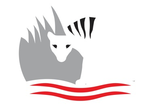THE MARQUESAS
French Polynesia is made up of 120 islands and atolls, stretching over 2,000km in the South Pacific Ocean. There are 5 main island groups: The Marquesas, The Tuamotus, The Society Islands, The Gambiers and The Australs. Each island group has a unique language, but French is taught in schools and is widely spoken. We are allowed 90 days in French Polynesia, as non-EU citizens so we plan to visit the first 3 mentioned groups and to divide our 3 months equally between them. That should be plenty of time, right?!
France in the South Pacific
Tahiti was made a French protectorate in 1842 and a colony in 1880. French missionaries went to the Gambier group in 1834, and in 1844 a French protectorate was proclaimed, followed by annexation in 1881. The Tuamotus were claimed as dependencies of Tahiti within the protectorate by France in 1847 and became part of the colony in 1880. In the Marquesas, Nuku Hiva was annexed to the United States in 1813 but the annexation was never ratified. French occupation of the group followed the landing of forces from a French warship, and in 1842 the chiefs ceded sovereignty to France. The islands were administered as the French Colony of Oceania and the territory went on to become autonomous in 1984. In March 2003 France changed the classification of French Polynesia from overseas territory to overseas collectivity. Nowadays tourism is a big money earner throughout French Polynesia and the French government still kicks in significant financial support.
Les Iles Marquises
The Marquesas Islands group is our first stop in French Polynesia and one of the most remote in the world. It lies 4,800 km west of Mexico (the nearest continental land mass). It is thought to have been formed by a centre of upwelling magma, called the Marquesas hotspot. The islands are characterised by towering, craggy peaks and lush green vegetation. The islands were colonized in the 10th century AD by voyagers from West Polynesia. Over the centuries that followed, the islands have maintained their unique cultures and languages.
Our arrival
It's mid-morning on our 18th day at sea when we start to see land - the cloud-topped mountain peaks of the island of Hiva Oa - at about 33nm out. The wind had been backing off, as was our boatspeed, which had fallen to 3.8kts – our ETA was getting later and later. We decide to put the engines on for the last 30nm so we can arrive in daylight. The anchorage at Atuona Bay is a tricky one, very tight and subject to swell and swirling winds. It also has to accommodate large supply ships on a regular basis, so we are hoping we can find a spot! As we get closer to the anchorage we can see a large monohull moored outside the bay, where it is a bit rolly. Turns out to be friends on VooDoo a Hylas 70 that we met in Bonaire and spent Christmas and New Year with in Santa Marta. We wait for a large ship (The Aranui V, a combination supply ship and cruise ship) to come out of the anchorage before heading in. The anchorage is tight but we somehow find a space. A few boats have stern anchors set to stop them swinging around. We find Glam as well (also friends from Bonaire/Santa Marta) which is lovely. We auto-connect to their WiFi as we go past them and our phone start pinging with lots of messages! Voodoo drop by in the RIB to say hi. So lovely to be greeted by friendly faces after such a long journey.
We have lost track of time on our journey but it turns out its Easter Saturday in this Catholic country so we can’t check in until Tuesday! A few bonus days to add to our 90 day allowance. We send off a few emails notifying family and friends of our arrival, and hit the hay fairly early. It’s nice to move back into our own side of the hull.
Tahuata Island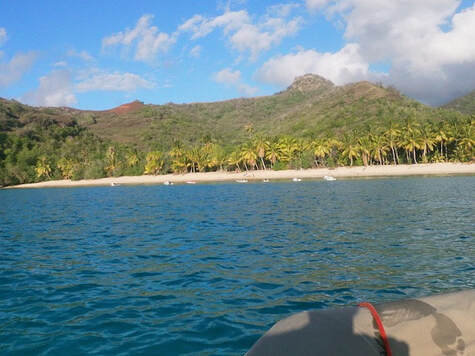 Beautiful white sand beach Beautiful white sand beach
We up anchor mid-morning and head the 12nm to the anchorage of Hanamoenoa on Tahuata. It’s a popular anchorage for cruisers, with a beautiful white sand beach the obligatory coconut palms. A welcome change from Atuona harbour and much more like what we expected to find on our arrival in Polynesia.
Despite averaging 6.8kts across the Pacific, we have a huge amount of growth on our hulls, including some reasonable-sized goose-neck barnacles. The brown goo spreads high above the boot stripe and it’s a dead give-away that a boat has just arrived in French Polynesia - along with the yellow flag of course! This is a great place to start trying to clean it off - it takes a fair bit of work and in some places it starts to stain the gelcoat. The water here is beautiful, warm and clear and we tackle a section each day. We head ashore in the afternoon for drinks on the beach with fellow cruisers. The beach is quite steep so you have to anchor your dinghy outside the breaking waves and swim ashore. Everyone floats around in the surf, chatting, getting dumped and giggling. Where are the dolphins?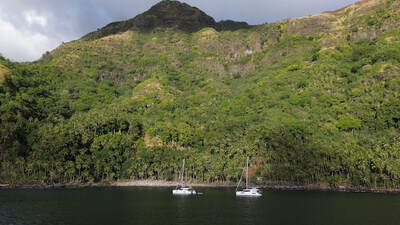 ITIKI & Glam, in "No Dolphin" bay ITIKI & Glam, in "No Dolphin" bay
We have been told about a bay where a pod of dolphins live and that we can swim with them. Not really sure about the location but it seems like a good idea. Glam head off and we follow, finding a nice enough bay (Hanetefau) that we think is the right one. Apparently the dolphins came in the morning, so we missed them and will have to wait. Glam team come over for coffee and banana cake instead. The next morning we don’t see any dolphins and decide it’s time to head back to Hiva Oa to check in and restock the pantry.
Checking in and getting stuff done
Atuona, Hiva Oa, is not a lovely anchorage, however here we have access to supermarkets, fuel, chandlery, sailmaker etc and we need to officially check into French Polynesia. As businesses open up again on Tuesday we reluctantly head back to civilisation. The town is 3.5km walk from the dinghy dock, slightly shorter if you cut across the beach and detour up the goat track, but our legs are a bit out of practice and there doesn’t seem to be any taxis. I spot the couple from the boat anchored in front of us getting into a rental car and in my best, very rusty French manage to cadge a lift into town. They are quite obliging, taking us around the key land marks including the gendarmerie, bank and supermarkets. Very nice of them. We go to check in which is relatively painless. Then we have to go to the post office to post our own customs form to Tahiti – less painless... The PO is only open in the morning as they are short staffed and the queue is a mile long. Not sure how it works though as people seem to come and go, seemingly other people have held their place for them. Finally there is general consensus amongst those waiting that it is our turn. We also get some local SIM cards so we are now back in business and can reconnect with the world. Of course the pantry is pretty bare, particularly of fresh foods, so we do the rounds of the supermarkets and buy way too much to carry. There is one restaurant in town and we struggle there with our booty and order one of two options that has not been crossed off the menu. Delicious curried prawns with frites and green beans. Meals are pretty pricey but we have since come to expect that in FP, eating out is expensive. The restaurant folk kindly offer to take us back to the port with all our shopping.
Kite sewing and sight seeing
There is not much to do or see in town, but our legs need some practice so we tackle the hike. We cut across the “beach” at the head of the bay, taking a big leap across a stream and then finding a steep, goat track up to the road. There are mango trees along the way and we help ourselves to some healthier looking specimens. In the town there is a Paul Gauguin museum which displays many copies of his artwork, stories of his time in Hiva Oa, French Polynesia and a recreation of the studio where he painted. Like many artists he died in poverty while his works went on to sell for $$$. He died in 1903 and is buried here in Hiva Oa.
After seeing the sailmaker to discuss our repair, and picking up our package, we head back to our now favourite, lovely beach anchorage at Hamanoenoa and wait for our boat buddy, Mai Tai to arrive. We spend a couple more days here, just enjoying the surrounds, with SUP trips ashore and walks along the lovely beach. Mai Tai arrives just after lunch so we take some fresh fruit and beer over to help them celebrate. Later we head ashore for sunset drinks so they can set foot on dry(ish) land. Great to have a debrief and celebrate their achievement.
Fatu Hiva
From our anchorage at Hanamoena Bay its 51nm to Hanavave on the island of Fatu Hiva. Many cruisers make landfall at Fatu Hiva to avoid the windward sail to get here from Hiva Oa. It’s not possible to check in at Fatu Hiva so doing this risks running foul of authorities and we had decided we did not feel comfortable with that, although after our passage here we could totally understand why people do it. We sailed down under main and Genoa, close hauled. Sea state was pretty bumpy with swell coming from two directions, a very short chop and quite unpleasant. We sail as far as we can but 12 miles out we are 7nm off course and going to miss the island completely, so we put both motors on, furl the genoa and head directly to our destinations. Had some dolphins drop by briefly to greet us, but it was too rough to go to the bow to watch them so they did not stay too long. Motoring into it wasn’t much fun either. Glam are already here and other friends and fellow cruisers arrive from their Pacific crossings whilst we are here, so we enjoy lots of celebratory catch ups.
The anchorage is spectacular, surrounded by lush green and very high hills on each side, with rocky outcrops that look like the famous easter island statues. Amazing! The bay used to be called the Bay des Verges (=penis) but the missionaries didn’t like this so they decided one of the rock/statues looked like the Virgin Mary and changed the name to the Bay des Vierges (=virgins). Nice one missionaries!
There is not much ashore, a small village and one shop, which wasn’t open very often. We met a local chap (Poi) who offered us some fruit and to take us on a tour of the island. We got some pamplemousse, limes and avocados and bought a bone carved necklaces from him, the Marquesas symbol. Walked up into the hills as far as the road would take us. It’s very green and fertile, with spectacular views through the valley and back down to the bay.
So many fellow cruisers have arrived, so we invited a few people over for drinks. They packed their kids off to Glam for movie night and the adults joined us. It got a bit ugly when Angus pulled out the Martinique rum… So lovely to hear everyone’s stories from their crossings.
Vaieenui Falls
We joined the gang of “kid boats” for a walk to the waterfall, it’s quite a crowd with all the kids but lots more fun. We weren’t paying attention and ended up taking a wrong turn but came across a pretty amazing tree with lots of roots. Doubled back and found the right path, which was pretty obvious, and walked through a farm past a very large bull who was sitting down calmly. The waterfall is a very high, shear faced cliff with not so much water falling. The water in the pool is clear and clean and everyone is in for a swim – so lovely and refreshing to swim in fresh water. We find a few eels and yabbies around the rocks. The kids and their dads decide to jump off the rocks into the water. On the way back the bull is up and about and being rather aggressive but we manage to scoot past him, fortunately his tether held him back! Later we pass some barking dogs and one of them goes for little Matilda. Keith runs at it, shouting and waving his hat and it runs off. She was quite rattled.
Back in the town we visit a lady who is making banane sechee or dried bananas, in her yard. This is a traditional Marquesan treat - the bananas are peeled, sliced in half and sun dried, then wrapped tightly in a bundle, tied with banana leaves (traditionally) or cling film (not so traditionally). We bought some of these as well as some local honey and also helped ourselves to some fresh rosemary from her garden.
Road trip, Fatu Hiva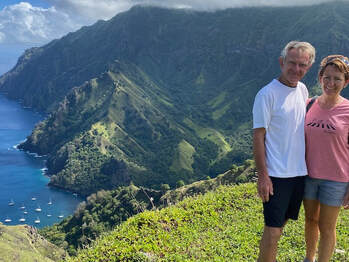 Overlooking the "Bay of Virgins" Overlooking the "Bay of Virgins"
There are only 20 odd kms or road on Fatu Hiva, nevertheless we can go for a road trip. We met Poi a couple of days earlier when he offered us some fruit and also to take us around the island. The roads are naturally very steep and negotiating the switch backs requires some concentration and a couple of 3 point turns. We stopped at a few different places to admire the views which were spectacular.
Poi explains about the “le trou d’amour” which is a small hole in one of the soaring cliffs overlooking the island. Legend has it that lovers had to go here to consummate their relationships otherwise they would not be accepted by the village. In reality though it is quite impossible to get to, even for mountaineers. The interior is rugged and the mountains steep and rocky. About 400 people live on the small village of Hanavave where we are anchored, a few more live in Omoa the southern village.
As we wind down the other side of the island the landscape changes - different types of trees here and it is much warmer and drier. The village is only slightly bigger than Hanavave but there are a couple of shops. We visit the community gathering area, a feature of many Polynesian villages, and here there is a great collection of stone Tikis. Some have been are gifted to Fatu Hiva by other Marquesan islands and show characters from legends and fables. We visit the church with its stain glass windows and beautifully carved wooden lectern and sacristy. Next it is on to see an artisan couple that makes tapas – not the Spanish foody kind! These are tattoo style ink paintings that are done on bark. The bark of the bread fruit tree (l’arbe a pain) and another type of tree are used. The bark is pounded until it is flat, thin and pliable, almost like a stiff leather, it can be white or fawn. We buy a white one of course, a lovely souvenir.
Poi tells us his wife is currently in Tahiti to give birth to their 3rd son. The health system pays for her to go but not him so he needs money for a ticket, which is quite expensive. We pay him the money for the tour and he promptly buys a bottle of rhum… Swimming with Mantas
In the afternoon there was much excitement on Miles Away, who are anchored nearby, as there were some manta rays swimming around the boat. Keith and I took a break from boat jobs and jumped into the water with camera and snorkelling gear. They were amazing to swim with, sometimes coming directly towards you with their huge mouths open. The water here is not so crystal clear so it seemed like they just suddenly appeared out of the darkness.
What exactly is a pamplemousse anyway?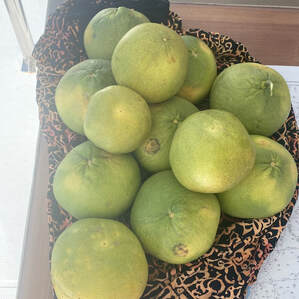 Freshly picked pamplemousse Freshly picked pamplemousse
On our walk around the village one day we came across an artisan making stone tikis. He had the chain saw out and was carving some red rock. We stopped to watch for a while and got chatting to him. He showed us an amazing chess set that he had carved from wood, each of the pieces was intricately done and the base of the table was carved into the shape of a turtle. He will be exhibiting this at an up-coming Marquesas expo in Tahiti in a couple of months’ time. It has taken him several years to complete the chess set, and he is still working on a couple of chairs to go with the table. He is responsible for a couple of the Tikis we saw over at Omoa as well including the lovely one of the couple back to back on the waterfront.
As seems to be tradition here, he generously offered us some fresh fruit. He disappeared for a few minutes and came back with several large pamplemousse which were growing in his garden. What is a pamplemousse? Well in short it is French for grapefruit, but these Marquesan pamplemousse are no ordinary grapefruit. They are at least twice the size of the standard yellow supermarket variety that we get back home, and at least 3 times as juicy and delicious. Just the right mix of tart and sweet. They grow like wildfire in these parts and wherever we go we are offered this delicious fruit, often for free. It takes a bit of practice to peel and pith them, the skin is very thick and each segment is covered by fibrous pith, but the rewards are worth it. Pamplemousse gin becomes a new cocktail our favourite around the anchorage!
Back to Hanamoenoa, Tahuata, again
Well it is such a lovely spot, it became our base to return to. Set out around 7am and the sail was much better than the way down, with swell from only one direction, it would have been good with the kite but that’s still with the sailmaker, so we had to goosewing instead with main and gennaker. Domino (a 35’ mono) who left around the same time, have an asy up doing good speeds and over took us at the bottom end of Tahuata. I got some photos of them with the kite up which I sent later. We get to Hamanoenoa and head to the beach with Ollie for the Mowzer twins 10th birthday party, complete with pamplemousse gin for the adults!
We spent the rest of the weekend here going ashore on the paddle boards, doing circuits with Zoe and Yoga with Erin, nice to get back into some physical activity.
A hard day & night
Hanamoenoa, Tahuata Island to Atuona Bay, Hiva Oa (8nm) to Hanamenu Bay, Hiva Oa (15nm) to Baie to Vaiehu, Oa Pou Island (65nm) – sometimes we just like to push ourselves! After yoga ashore we head off to Atuona, Hiva Oa to collect our Parasailor. The bay is full and it’s difficult to find a place to anchor with boats swinging every which way. We end up near the mouth of the bay, not ideal and very rolly, but good holding.
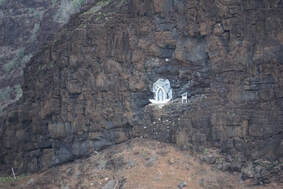 Virgin Mary up in the cliffs Virgin Mary up in the cliffs
The boat is a bit of a shit fight but with missions accomplished there is no need to stay in this horrible anchorage so we fire up the engines and head off, hot and exhausted already and its only lunch time. We manage to pull out a sail for a bit but as we get closer to our destination, and around the western-most point of Hiva Oa where the wind turns onto the nose as it wraps around the top of the island. We have wind over tide, short sharp chop which is uncomfortable but only for a couple of miles. The anchorage is a long bay, deserted and seems well enough protected. There is a statue of the virgin Mary perched precariously, high up on the cliffs above us. I don’t think she gets too many visitors.
2 Comments
How we crossed the ocean
From The Galapagos Islands of Ecuador to the Islas Marquises of French Polynesia will be the longest single leg of our journey home in ITIKI, at 3020nm (that's 5,600kms)! After a very easy run down from Panama to Galapagos, and after a lot of discussion and reflection on how far we have come, the passages we have done, the conditions we were expecting, we decided not to take on any crew for this passage. It would just be the two of us. We felt confident we could do it, mentally and physically, although in the back of my mind I knew it would be challenging for me if something happened to Keith. We felt we were pretty well prepared though, and although you can’t control everything on balance we were quietly confident.
To put our journey into perspective, this 3,000nm leg to the Marquesas from Galapagos is nearly 5 x the Sydney to Hobart yacht race (which is 628nm). Since we picked up ITIKI in La Rochelle we have done 19,000nm (34,000km) as far as the Galapagos. The furthest point east we made it was in Turkey, which is now 7,150nm away (13,240kms, as the crow flies) from Galapagos. Our home town of Sydney now lies 6,950nm to our west. Once we arrive in the Marquesas we will be only 3,900nm (7,200kms) from home!
How do you prepare for 3 weeks at sea?
We expected the Pacific passage to take just under 3 weeks in total, assuming we would head south to pick up the easterly trade winds and then turn right to have a down-wind run. This leg is known as the Coconut Milk run after all. Preparing for any long passage, the main focus is on safety of course but comfort has to come into it as well. We have a checklist of standard preparations, here are some of the key points:
And we are off!
With the Galapagos exit inspectors gone, we have a final cup of tea and can delay no longer. We lifted anchor about 11:30am, John and Gill from SV Mehalah waved us off. Bearing in mind we are still in the area called the Doldrums, we expected some lightish conditions before getting into the solid and reliable easterly trade winds. We were advised to head south to 4-5 degrees latitude, before turning right to run downwind. We have a good SE breeze initially steady at 12kts so it's perfect for the gennaker. Seas are flatish initially with good current in our favour so we are making great speeds. The wind soon built to the limit of the gennaker so took it down, and didn’t lose much in speed at all with the genoa.
That’s been a long time coming!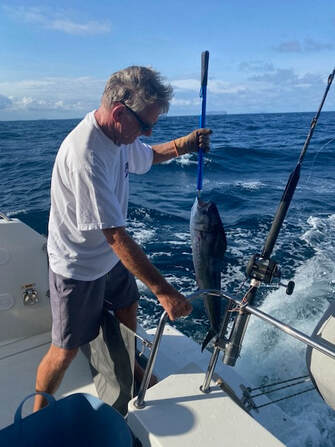 Keith vs Mahe Mahe Keith vs Mahe Mahe
Just before 4pm, just to the south of Isabela, we heard a sound that we haven’t heard before. Yes the zing of the fishing rod! I bring the boat up head to wind to slow her down while Keith tries to reel it in. We were doing 8s and I dropped her down to 4s which seemed to be enough. Keith thinks we have lost it for a while but as it comes closer we see the unmistakable shape of a Mahe Mahe, and a good sized one too. I frantically rifle through the lazarette to find gloves, the gaff, the woefully inadequate net and finally the big blue plastic bucket. The fish is really fighting as he gets the transom, Keith gets the gaff in but it is not a fatal blow. Sadly it is not a quick death and we both really feel for this creature. We tell ourselves we will honour it by savouring its flesh…. As it dies the bright yellow colour slowly fades. I manage to take a few pictures and get a message off to Ollie from Mai Tai, whose rod we are using, and TheWildThings, who gave us our most recent fishing lesson. Keith manages to kill our catch with the filleting knife and eventually hacks off the head and removes the intestines without puncturing them. I find the fishing book and open it to the filleting page and set up the BBQ/filleting tray. Keith does his best to skin our catch - all up landing the fish and getting it filleted took about 1.5 hours. I am sure we will get better with practice! Anyway that’s dinner sorted tonight, and tomorrow night, and 2 more serves in the freezer. I am glad I didn’t rush to the fish markets this morning! It was also lucky we had the genoa up and not the gennaker as we probably would have had to furl the latter and probably would have lost the fish and all the line!
Strange Currents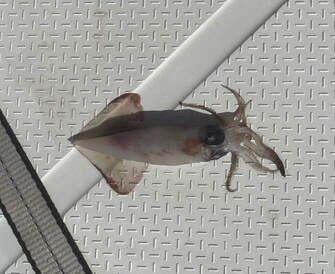 One of many flying squid that we caught One of many flying squid that we caught
On my watch around 3am we go through a very strange patch of water. It was dark but it suddenly sounded like we were sailing through rapids. I put the torch out and saw flatish whitecaps even though we only had 8kts TWS. Wind over tide it seems as the current was 2kts on from our starboard side, on the beam, whilst the wind is directly opposite on our port beam! The torchlight picks up hundreds of tiny fish (or maybe even squid) jumping and occasionally something larger chasing them! I also see some floating plastic bottles. This lasts about 20mins and we are back to normal seas again. Very strange.
Later that afternoon I see some whale blows about a mile away, then some dorsal fins and later 2 small whales breaching. Its lovely to see them but the recent experience of SV Raindancer I mentioned earlier puts a dampener on the experience. Sunset is spectacular with the clouds on the horizon looking almost like trees. There is a sliver of a moon just above the coral coloured horizon which sinks not long after the sun. The sky is fairly clear most of the night and stars are magnificent. Rinse and repeat
As the journey rolls on, the days start to blur and become repetitious. It is a little boring, which actually is a good problem to have! With just two of us, we keep a pretty standard 4 hour watch system. It goes like this:
We keep the same times and fall into a routine. During the day when there is good visibility we rely on the autopilot and use the time to do odd jobs, prepare meals, catch a few zzzzs etc Once the sun goes down we are stricter about keeping a look out. Fishing boats become rarer, but they are often not on AIS and so we keep a lookout for lights on the horizon. When off watch, catching up on rest and sleep is really important. On shorter, overnight passages through busy traffic areas the “off watch” person sleeps in the saloon on the sofa to be close at hand, but on this longer passage where there are few other boats around, its nice to sleep in our own bed, even though we are not in it at the same time. The only problem is that the autopilot is on the starboard side and the intermittent and irregular groaning coming from the hydraulic arm of the autopilot is enough to drive one crazy, as it is right next to your head. So we make up the bed in the port aft cabin and that is where we end up sleeping when off watch. Lovely and quiet!
WE FIND THE TRADE WINDS - Parasailor up!
The are 10 degrees to the north and south of the Equator is known as the Doldrums. In this region, the winds can be fickle and at times non existent. We have been fortunate that we have had enough wind to sail all the way from the Galapagos.
On the afternoon of day 4 we hit the jackpot – we find the trade winds at around 4degrees south. The wind angle is now perfect for us to turn right so we changed to the Parasailor. This involves furling and stowing the gennaker, putting engines on so we can come up head to wind, dropping the main then turning downwind again onto course, hoisting and launching the Parasailor. We love our Parasailor, its easy to manage and in calm conditions it can keep us moving along nicely. We hoisted it in light winds, which were directly from behind. Progress was slow at first, it’s not our fastest angle of sail, but the creak and flog of the mainsail was gone and the sail just looks after itself. It rotates from side to side as the wind direction shifts through a few degrees, or the angle of the boat changes as we are picked up or nudged along by waves. It makes for very pleasant sailing conditions. We are sailing on apparent wind hold which keeps us trimmed to take advantage of any wind shifts. We are making great progress west and slowly creeping southwards as well as westward.
After dropping the main we noticed that the outer sheath of the 1st reefline had chafed through – again! This line has been chafed through, chopped off and re-led several times now, each time we think we have figured out and bypassed the problem but it seems not. This time Keith puts a Technora sheath over where we think the chafe point is. Let’s hope we have nailed it now.
Loved to death!
Fast forward to day 17 and we started getting some blustery conditions with the wind becoming increasingly shifty. We had to intervene a bit too often, changing course to ensure that the kite stayed full and trimmed. Sudden wind shift collapses the kite before the autopilot, or the person on watch, can react. This happened a few too many times and we should have seen the writing on the wall, but sadly after one big collapse, the force of refilling the kite ripped the top of the sail horizontally, just above the wing. I was on watch but Keith heard the bang of the wind refilling the sail and was quickly up from the bed to investigate. He was standing in the saloon when I told him we had ripped the kite but he was looking very confused like he didn’t believe me. From where he was standing he could see the bottom half of the kite still flying perfectly trimmed! Meanwhile the sky was visible through the top half!
Regular readers will recall that we shredded the lower half of the kite on our Atlantic crossing. This lower half was ripped up so badly it had to be completely replaced with new cloth. Thankfully this part is still intact, as is the wing. The upper section was the original cloth and had clearly seen more sunshine, moonlight and good times! We were able to snuff the kite and change to the main and Genoa (both with 1 reef) in time for sunset. Squally conditions continued throughout the night with dark, dense clouds passing over is, bringing more wind and some rain. We passed a freighter going the other direction whilst in the midst of a particularly nasty patch so had to hold a tight course. Shifty and gusty winds made for a busy and bouncy night. Our milk run has turned into a milk shake as seas are quite big too but all is well on board. At least we are making good speed!
Parasailor in the sail loftOut of sight, out of mind
It was about 25 miles from Isabela, Galapagos, when we lost sight of land. We essentially went 18 days and nights without seeing land. The further we went into the Pacific, the further we got from land and civilisation. Once we reached the middle of the Pacific, we were 1,500nm or 2,780 km) from land, which is way further than the International Space Station at 408km from Earth! Have you ever wondered what that feels like? Me too. Amazing, daunting, somewhat unnerving, but we don’t really spend too much time dwelling on it. I think that if you did you could very easily become unhinged. At sea level it is 3 miles to the horizon, so looking all around us we see a 6 mile diameter circle of sea, our planet, our world. Our universe crunches down to our 13.3m x 7.6m space called ITIKI. A bit like the 2 weeks of quarantine in the early days of CoVID, except no Netflix and no sending out for Uber eats. Alot of yachts have got StarLink now but it’s actually quite nice not having internet, a good reminder of how much time you can waste going down rabbit holes.
Instead we are living in the moment, focusing on keeping the boat moving and systems running smoothly. We get occasional messages via the Sat phone from other boats nearby, and the novelty reminds me of the early days of dial up internet! A well oiled Machine
We are carefully monitoring the battery levels and managing our power. We need to keep our fridges and freezers running but also keep the autopilot working, so we don’t have to hand steer! If we don’t get enough power from the sun because of cloudy days or shading from the sails, we need to run the generator. We make water every few days to keep the tanks nice and full, and keep up with the washing. There are always odd jobs to do, and we regularly check the boat for wear and tear, chafe or compression on lines and we rock the Parasailor Halyard every second day.
I make bread every second day, yoghurt twice a week, and am often planning and cooking meals etc. We make sure we look after ourselves, it’s important to eat well and drink plenty of water. We listen to podcasts, our late afternoon ritual which has replaced “sundowners” - working our way through the gripping BBC podcasts “13 Minutes to the Moon” and “The Lazarus Heist”. We read, do Sudokus, sort out photos and try to catch up on blogs. What time is it?
We end up crossing several time zones on our way across the Pacific. Friday night is usually marked by a Cosmopolitan so in keeping with tradition we enjoyed the “on passage” version of this classic cocktail, listened to a podcast and watched the sunset. It’s easy to lose track of time when the Parasailor and autopilot are doing all the work! I was officially on watch but it was lovely to share time together at the helm rather than being ships that pass in the night!
Keith did the 8pm til midnight watch while I slept. When I woke and checked the time on my iPad I saw I had overslept by 40mins! Why had he not woken me?! That’s the rules! When I got up there was much confusion as the chart plotter was showing 1 hour earlier than our phones. Keith was insistent he had not extended his watch, and indeed had only ticked off 3.5 hours. Hmmm… It seems that the chartplotter had changed time to 1 hour earlier but when? It took us a while to realize that it had done this during cocktail hour without us noticing! All very confusing but at least we had shared “the long watch”! Over the rest of our journey the chart plotter changed time zones several times, until we finally got into Marquesas time, there were a few longer watches which was a bonus for whomever was off watch! Weather conditions
Well over a period of 18 days of our passage we obviously had a lot of different conditions, but overall it was a relatively easy passage. We managed to sail pretty much all the way from leaving Galapagos at one end, to seeing land at the other end. We never lost the wind completely as some yachts did. We always had more than enough breeze to keep moving. The only time we motored was to take down the mainsail and change to the Parasailor, and on sighting land 33nm out. Sometimes keeping us moving entailed a fair bit of work and concentration, playing with the wind angle to get the most out of our sails, other times we just sat back and let the autopilot do all of the work! Sometimes we were grateful to just be moving at 2-3kts. For the first half of the trip we had a good 1-2kts of current with us which was a real bonus. At the other end of the scale, we rarely had gusts over 25, and if we did it was short lived. We had the odd squall but interestingly, whilst we regularly saw thick, low, dark cloud they often did not show anything on the radar, rarely lifted the wind considerably and brought little to no rain and – thankfully – no lightening. We know of one yacht that copped a direct hit from lightening mid-Pacific which took out 90% of their electronics including main and back up autopilot. What a nightmare!
There were times when the sea state was less than pleasant, rather than the nice easy following sea we expected. At times we had waves hitting us on the beam, not coming from the same direction as the wind. This usually means that the wind direction has changed recently and the wave systems have not caught up. We had around 20 hours of really nasty swell and rough seas but nowhere near as bad as our Atlantic crossing – just not fun. And suddenly its over!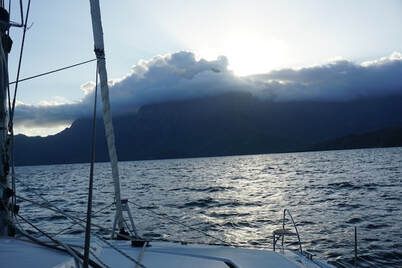 Hiva Oa, French Polynesia Hiva Oa, French Polynesia
Its mid-morning when we start to see land. The island of Hiva Oa is quite high and we are about 33nm out. The wind has been backing off and we are doing 3.8kts of boatspeed, and the expected arrival time is getting later and later. We decide to put the engines on for the last 33nm so we can arrive in daylight. As we get close to the anchorage we can see a large yacht moored outside the bay, where it is a bit rolly. Turns out to be our friends on VooDoo a 70’ Hylas which is just too big for the tight anchorage. We wait for Aranui V (well known, cargo / cruise ship) to come out before heading in. The anchorage in Atuona Bay is pretty tight but we find a space in the middle. A few boats around the fringes have set stern anchors set. We find SV Glam here as well which is lovely (especially as we can get onto their internet!) Voodoo drop by in the RIB to say hi, everyone is heading to another nearby anchorage tomorrow as we can’t check in until Tuesday, because it is Easter Saturday in this Catholic country. We send off a few emails and hit the hay fairly early. It’s nice to move back into our own side of the hull.
The 3,020 nm from Santa Cruz, Isabella took us 18.5 days (factoring I the time changes) and we averaged 6.7kts boat-speed. We have zero fresh fruit left and vegetable wise, half a cabbage and a potato, but plenty of meat, lentils and cans! The Parasailor was our only casualty and we can get that fixed in Hiva Oa. All in all it was a very easy and satisfying journey and importantly we are still speaking to each other! To read our daily log, check out our journey on noforeignland via the link below: |
AuthorAfter more than 5 years of (minus time off for Covid) and more than 27,000nm Lynda has finally got the hang of this cruising life Archives
June 2024
Categories |
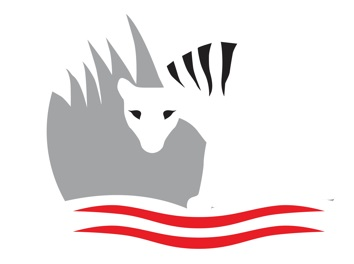
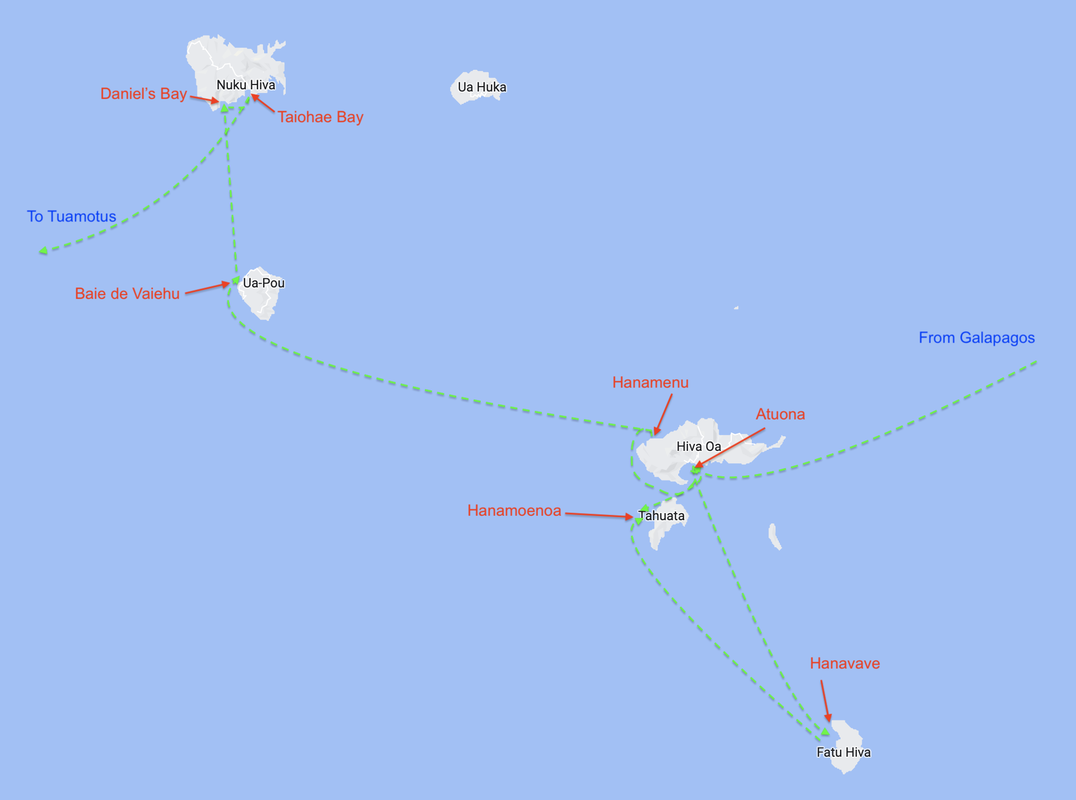
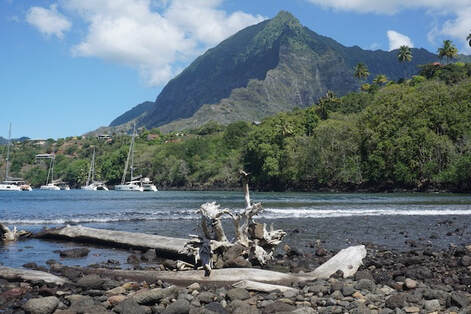
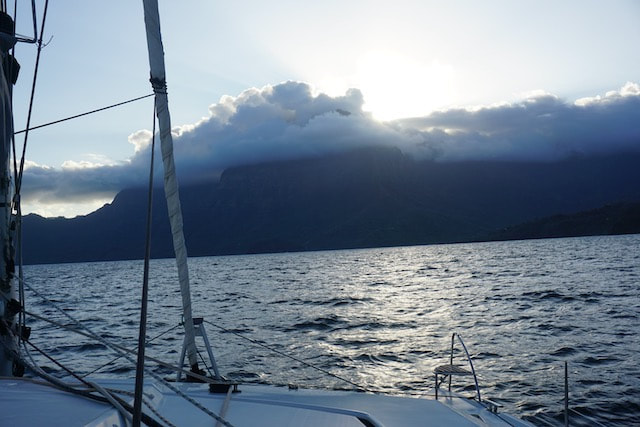
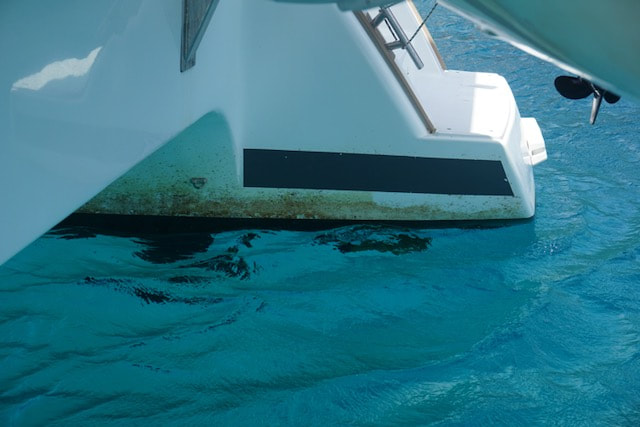
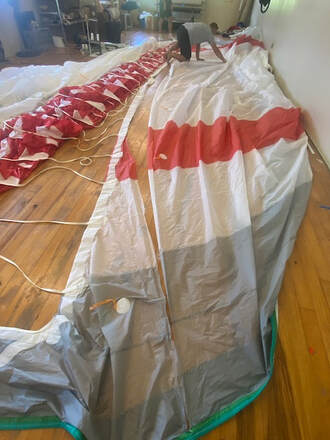
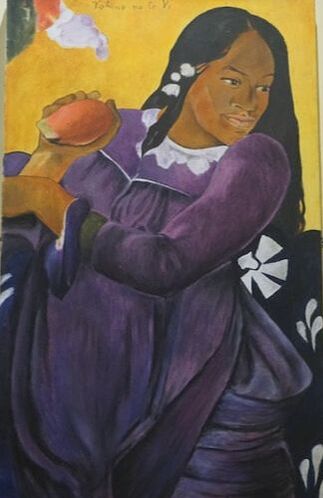
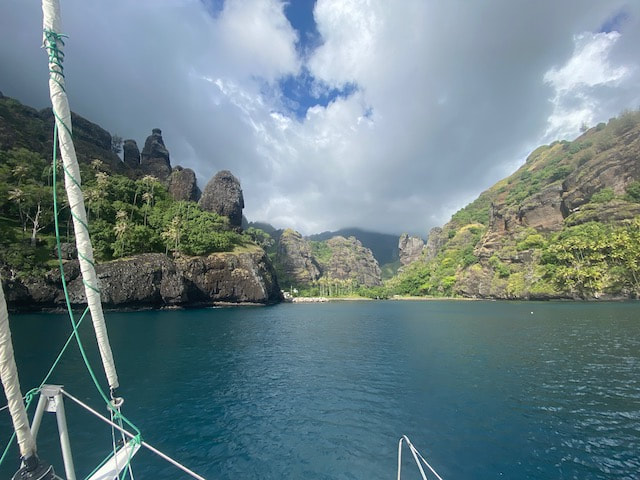
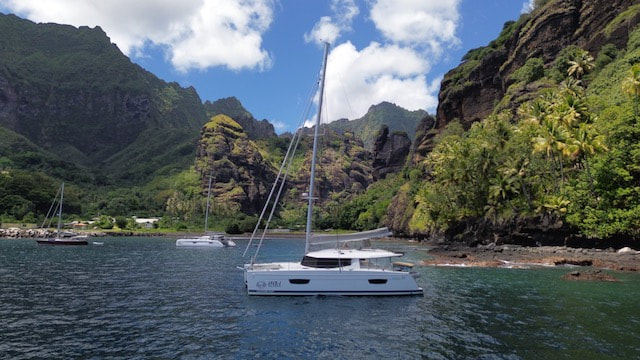
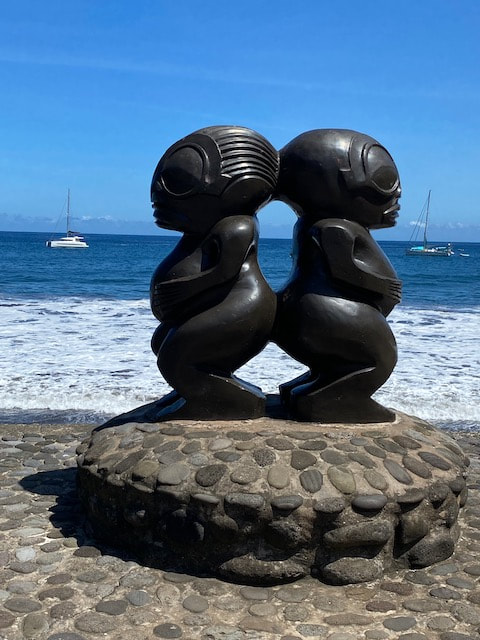
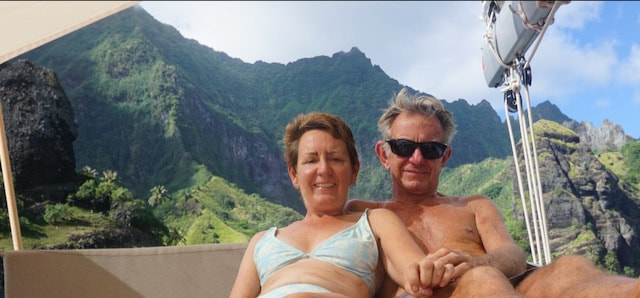
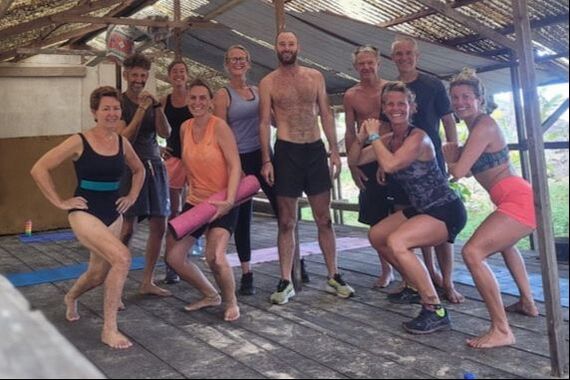

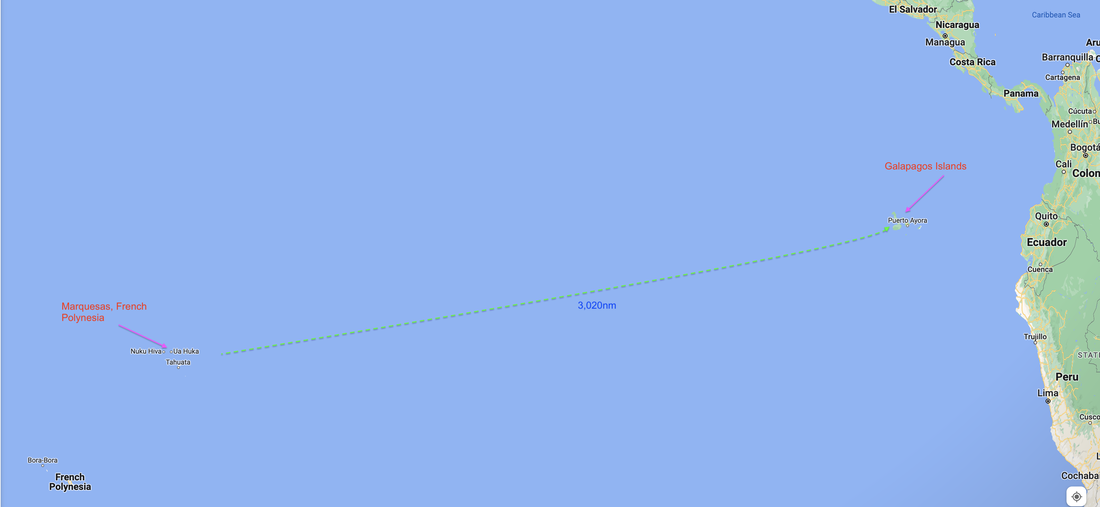
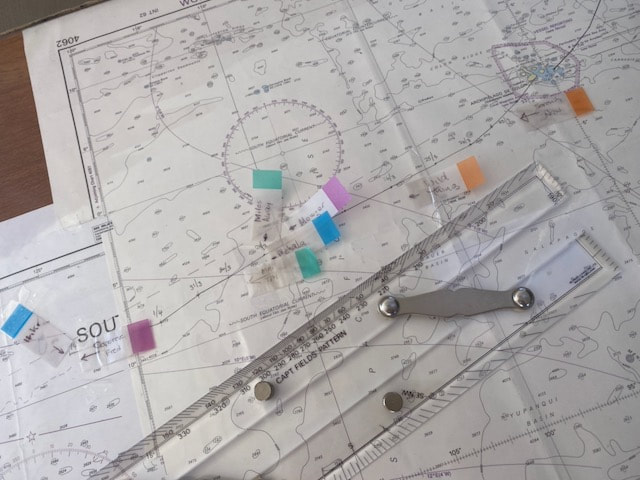
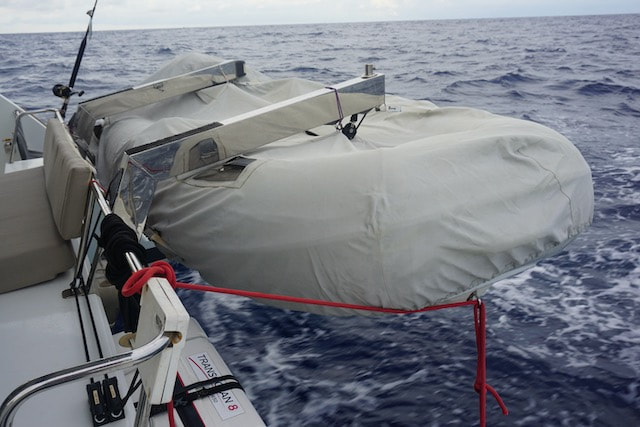
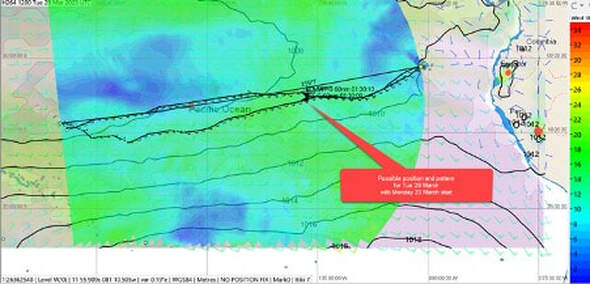
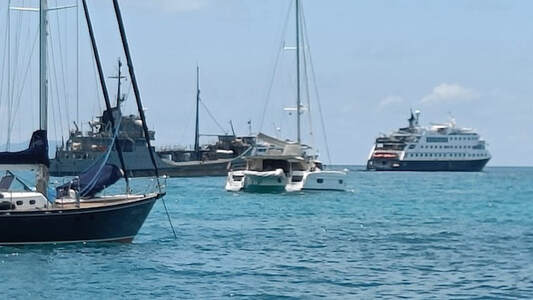
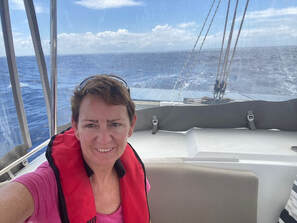
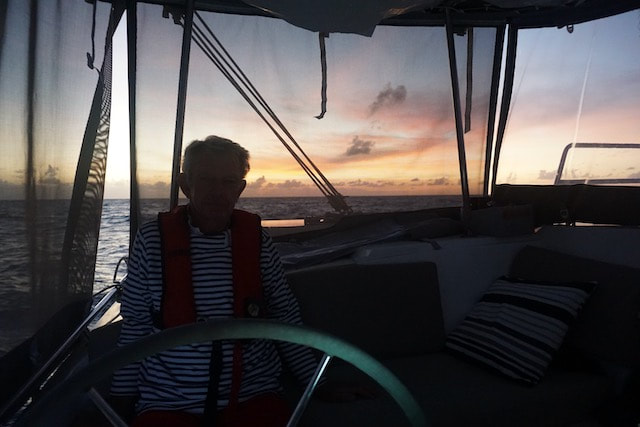
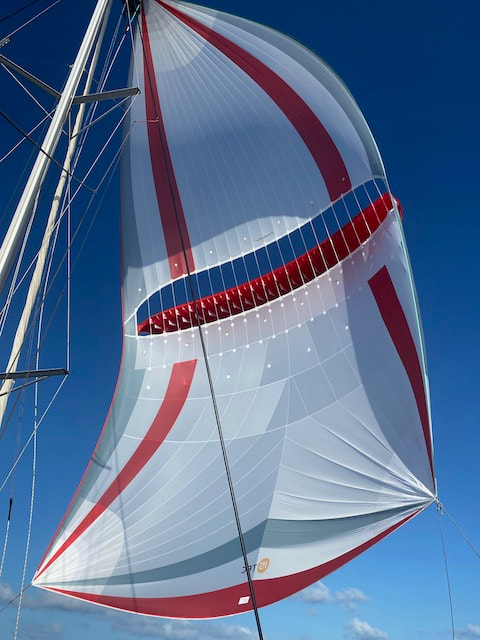
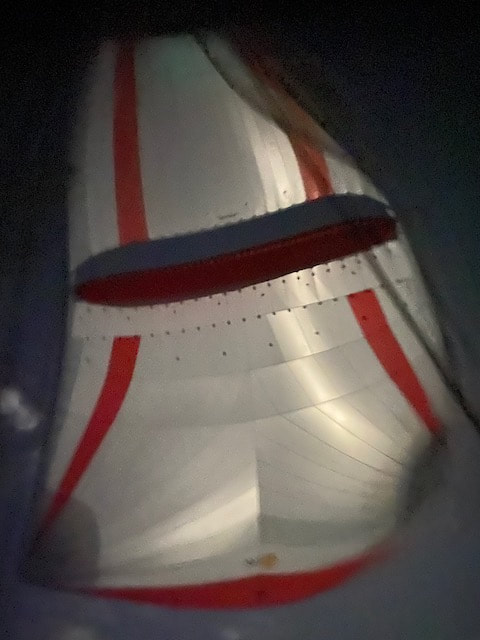
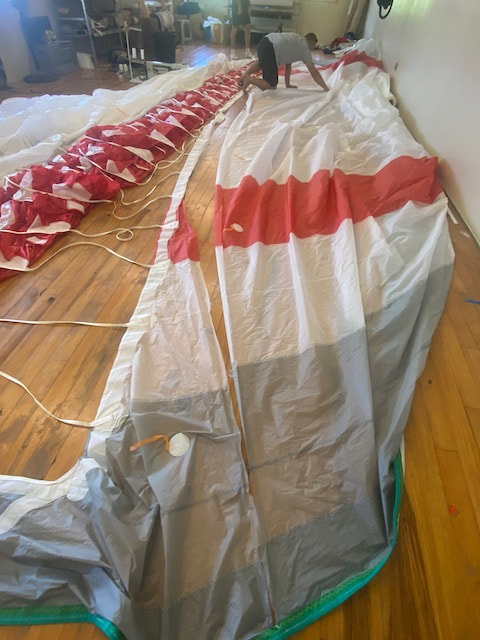
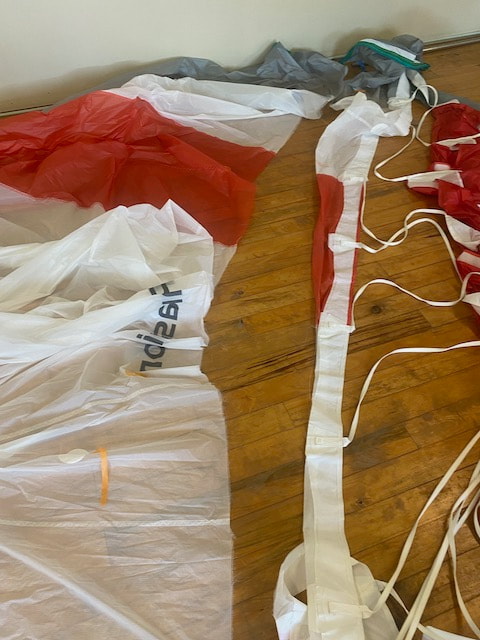
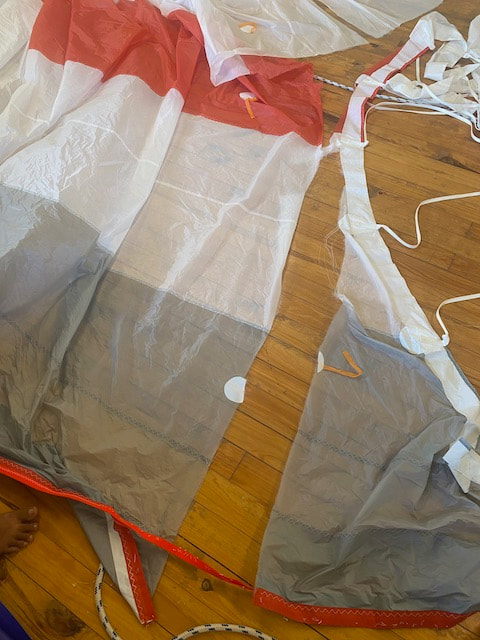
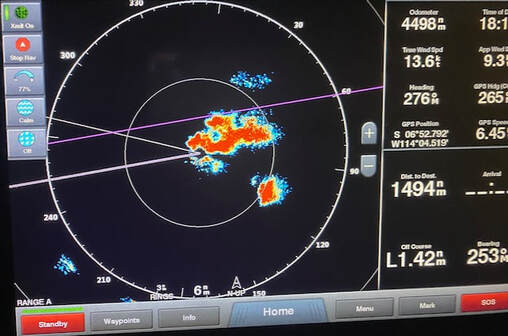
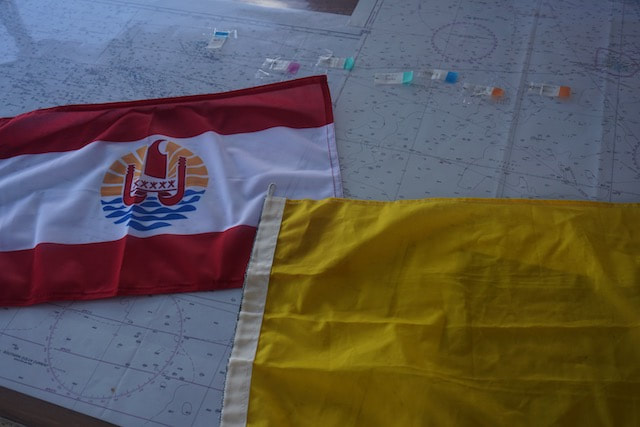
 RSS Feed
RSS Feed
